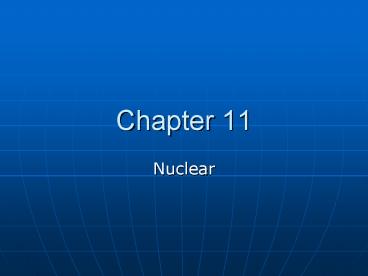Nuclear - PowerPoint PPT Presentation
1 / 22
Title:
Nuclear
Description:
Nuclear- changes w/in the ... Fusion- 2 smaller atoms combine to make 1 larger atom of a ... Entombment- permanently encast plant in concrete (problem ... – PowerPoint PPT presentation
Number of Views:56
Avg rating:3.0/5.0
Title: Nuclear
1
Chapter 11
- Nuclear
2
PGE Bill
- PGE Website
3
Definitions
- Combustion- chemical reaction
- Nuclear- changes w/in the nuclei of atoms
- Fission- large atoms split into 2 smaller atoms
of different elements - Fusion- 2 smaller atoms combine to make 1 larger
atom of a different elements
4
- Nuclear reactions produce 100,000x more than
energy per atom than chemical reaction - The atom
- Atomic Mass- sum of protons neutrons in nucleus
- Atomic Number- of protons per atom
5
More Definitions
- Isotopes- forms of a single element that differ
in atomic mass (due to different of neutrons) - Radioisotopes- unstable isotope that
spontaneously emit a form of energy consisting of
particles (radiation) - Radioactive Decay- process of a radioisotope
emitting radiation whose nucleus changes into the
nucleus changes into the nucleus of a different
element as a result of the radiation - Radioactive half-life- period of time required
for one half of the total amount of a radioactive
substances to change into different material
(daughter product) - Nuclear power plants use fission.
6
Nuclear Fission
- Uses uranium as fuel
- Non-renewable resources
- Found predominantly in Australia, Africa, North
America (Winnowing, Texas, Colorado, New Mexico
Utah)
7
- 3 main uranium isotopes
- U-238 99 of ores, not fissionable, waste
product of conventional nuclear fission - U-235 0.71 of ore, used in conventional nuclear
fission but must be refined to 3 (enrichment)
(Bomb grade is 20) - U-234 lt0.01 of ore
8
Fission Process
- Enriched uranium (U-235) ore formed into pellets
placed in fuel rods - Fuel rods put into fuel assemblies placed in
reactor vessel - Reaction controlled by control rod
- In fission process, U-235 is bombarded w/
neutrons which splits the atom releasing energy
daughter product
9
- Energy is in form of heat gt used to form steam
generate electricity (steam turns turbine which
turns generator which makes electricity) - Fission occurs in reactor core
- Condenser used to cool steam
10
- http//reactor.engr.wisc.edu/pics/reactor2.gif
11
Water cooling
- 3 water circuits
- Primary (closed)- pulls heat from reactor core
- Secondary (closed)- moves heat from primary
circuit and turn turbine - Tertiary- cooling water to cool secondary circuit
- Reactor vessel and generator/water system are in
containment building
12
Breeder Nuclear Fission
- Alternate type of nuclear fission
- Uses U-238 and changes it into Pu (plutonium)
-239 to use as a fuel in the reactor - Breeder reactors use have many safety problems.
Main one is use of liquid sodium as coolant (a
highly reactive metal that explodes when in
contact with water and burns spontaneously in air
at high temperature) - Plutonium also used in nuclear weapons
13
What are the advantages and disadvantages of
Nuclear Power?
- Advantage of nuclear- less environmental impact
than fossil fuels - Disadvantage- radioactive waste spent fuel gt
storage problems
14
Nuclear Power in US
- 104 nuclear power plants in US (434 world wide)
supply 19 of nations electricity - Nuclear plants regulated by US Department of
Energy, Nuclear Regulator Agency
15
- Internationally- Intl Atomic Energy Agency
(IAEA) - Effects of ionizing radiation (contains enough
energy to eject electrons from atoms) damages DNA
(mutations) resulting in birth defects, mental
retardation or genetic disease - Mutations in genes controlling cellular growth
may convert them oncogenes (genes that cause
cancer)
16
What do we do with the waste?
- 1 problem with plants dealing with wastes
- 2 types of waste
- Low-level radioactive wastes- radioactive solids,
liquids and gases that give off small amounts of
ionizing radiation and include glassware, food,
paper, clothing, etc. - High-level radioactive wastes- radioactive
solids, liquids and gases that initially give off
large amounts of ionizing radiation and include
reactive metals, coolants fluids and reactor gases
17
- 1980 Low-level Radioactive Policy Act
- Specified all states are responsible for the
wastes they generate and encourage states to
develop faculties to handle low-level wastes - No permanent facility for high-level wastes
(Yucca Mountain is proposed location) - 72 temporary sites in US
- 1982 Nuclear Waste Policy Act- requires federal
government to find permanent disposal site and be
operational by 1998
18
Pros/Cons of Yucca Mountain
- Near volcano and earthquake fault line
- Transportation of high level wastes is a problem
- Dry areagtdeep ground water
19
Decommissioning (closing) Nuclear Power Plants
- Storage- simply guard the plant for 50-100 years
during which some radioactive material will decay
and is safer to handle - Entombment- permanently encast plant in concrete
(problem tomb will have to remain intact for at
least 1000years) Chernobyl- heat of radiation
caused concrete to crack - Decommission- dismantle plant after it closes.
All materials taken to permanent storage sites
after torn down
20
Radioactive Waste Disposal
- Liquid wastes- highly unstable and difficult to
monitor must be converted to solid form via
vitrification (conversion to solid glass or
ceramic logs) - Solid Waste- Consolidation and storage/monitoring
underground
21
Fusion
- Combining 2 lighter atoms into one large one
producing very large amounts of energy - Animation
- Isotopes of hydrogen (heavily hydrogen or
deuterium) used for the process - Radioactive Tritium is formed by fusion
(man-made not found in nature) - Tritium and deuterium formed together to create
energy and Helium-4
22
Fusion
- Advantage- no high-level radioactive wastes
(low-level wastes produced) - 1 problem- requires very high temperature
- 2 problem- confining fuel
- Super heated ionizing gas (plasma) has tendency
to expand and nuclei arent close together and
will lose energy when hit container wall (looking
_at_ magnetic fields for containment)































